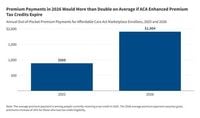Hoosiers and millions of Americans across the country are bracing for a dramatic surge in health insurance premiums in 2026, as a perfect storm of rising medical costs, expiring federal subsidies, and political gridlock threatens to upend the Affordable Care Act (ACA) marketplace. According to a September 30, 2025, report by the Indianapolis Business Journal, five major Indiana insurers—Anthem, UnitedHealthcare, CareSource, Cigna, and Coordinated Care Corp.—are set to increase premiums by an average of 31.4% starting January 1, 2026. This marks a staggering jump from last year’s 3.35% average hike and far outpaces the national average increase of 18% projected for ACA plans in 2026, as reported by KFF, a nonpartisan health policy research organization.
More than 359,000 Indiana residents—nearly triple the number from a decade ago—now rely on marketplace plans, which are designed for those without access to employer-sponsored insurance, including students, the self-employed, and workers at small businesses. But the looming price hikes have ignited concern among doctors, hospitals, patient advocates, and policy experts, who warn that tens of thousands could be forced to drop coverage entirely. “They may ignore or minimize their own symptoms for fear of what it may cost and end up letting a small problem go for far too long,” said Dr. Ryan Singerman, president-elect of the Indiana State Medical Association, in a statement to the Indianapolis Business Journal. “Then it may end up being something really tragic.”
The situation is further complicated by the scheduled expiration of enhanced federal tax credits—known as premium tax credits or, more recently, as “Biden’s COVID Credits”—which have helped millions afford their ACA plans since 2021. These credits, first expanded under the American Rescue Plan Act in response to the pandemic, are set to lapse on December 31, 2025, unless Congress acts to extend them. Nationally, 22 million ACA enrollees benefit from these subsidies, and their loss could more than double premiums for recipients, according to a new KFF analysis. The report estimates that average premiums would leap from $888 in 2025 to $1,906 in 2026—a 114% spike—if the enhanced credits expire as scheduled.
Indiana could be hit especially hard. About 97,000 Hoosiers—and 4.2 million Americans overall—risk losing their insurance if the enhanced tax credits vanish, KFF warns. “Without the enhanced subsidies that will soon expire, the marketplace is certainly not affordable for most Hoosiers,” said Susan Jo Thomas, executive director of Covering Kids & Families of Indiana. She adds, “The catastrophic plans will be the only affordable choice for most people, yet those plans offer a risky option for the average Hoosier.” Catastrophic plans, with their lower monthly premiums but sky-high deductibles, mean that many would face steep out-of-pocket costs before insurance coverage begins.
Insurers and benefits managers point to a host of reasons for the premium increases, most notably the relentless rise in medical costs. According to reporting by Epic for America, health insurance companies cite factors such as a nationwide labor shortage for healthcare workers, the surging cost of prescription drugs—especially high-cost specialty medications like GLP-1 weight loss drugs (think Ozempic)—and the growing demand for advanced diagnostic imaging. Hospitals are paying higher wages to attract nurses, physicians, and other skilled staff, while an aging population is driving up utilization of expensive medical services. Health System Tracker, a respected industry analysis group, estimates these factors account for more than half of the premium increases for 2026.
Economic uncertainty and new tariffs are also fueling insurers’ requests for higher rates. Concerns about drug prices and the broader economy, along with inflation that has ramped up during the Biden administration, have contributed to higher labor and administrative costs for insurance companies. Health System Tracker estimates that tariffs and economic uncertainty alone account for about a fifth of the coming premium hikes. “For individuals with no access to group coverage and those losing premium credits, their coverage costs will definitely skyrocket,” said Stan Jackson, chief innovation officer for Apex Benefits, to the Indianapolis Business Journal. “Most likely, people will drop their coverage because of affordability.”
The expiration of the enhanced tax credits is not the only factor at play. According to Epic for America, insurers expect that when these credits expire, enrollment—especially among healthier individuals whose plans were heavily subsidized—will decline. This shift would leave a risk pool that is older and less healthy on average, driving up costs for those who remain. The analysis also notes that the COVID credits have led to substantial improper payments: an estimated $27 billion in 2025 alone, with millions of people fraudulently enrolled without their knowledge. In 2024, insurance companies reportedly received at least $35 billion in subsidies for about 12 million ACA enrollees who made no medical claims that year. About 40% of those fully subsidized did not file a single claim, even for a checkup or prescription.
Nonetheless, KFF’s analysis is clear that the loss of enhanced subsidies would be a seismic shock for consumers. Without congressional action, a 60-year-old couple earning $85,000 (just above 400% of the federal poverty level) would see their yearly premiums rise by over $22,600 in 2026, after accounting for the loss of enhanced credits and insurers’ rate increases. Even lower-income individuals would not be spared: a 45-year-old making $20,000 in a state that hasn’t expanded Medicaid would see benchmark plan premiums jump from $0 to $420 per year on average.
The political standoff in Washington is only adding to the uncertainty. As of the end of September 2025, Democrats—led by Sen. Charles E. Schumer and Rep. Hakeem Jeffries—are demanding an extension of the enhanced subsidies as part of a deal to fully fund the federal government for fiscal year 2026. “At a time when families are already being squeezed by higher costs, Republicans refuse to stop Americans from facing double-digit hikes in their health insurance premiums,” Schumer and Jeffries said in a joint statement. Republicans, on the other hand, insist that any negotiations on the credits should take place after a funding resolution is passed, rejecting immediate extension demands. Senate Majority Leader John Thune stated, “They can work with Republicans, or they can shut down the government with all that will mean for the American people,” according to the Associated Press.
With the upcoming ACA enrollment period set for November 1 to December 15, 2025, and coverage beginning January 1, 2026, thousands of Hoosiers and millions nationwide are facing a critical decision. As Dr. Singerman put it: “We are sitting in the middle of not exactly the most robust economy by many metrics, and to look at these tax credits going away, we’re expecting insurance premiums to pretty much skyrocket.”
The debate over ACA premium hikes and the future of federal subsidies is far from settled, but one thing is certain: the stakes for ordinary Americans have rarely been higher.

